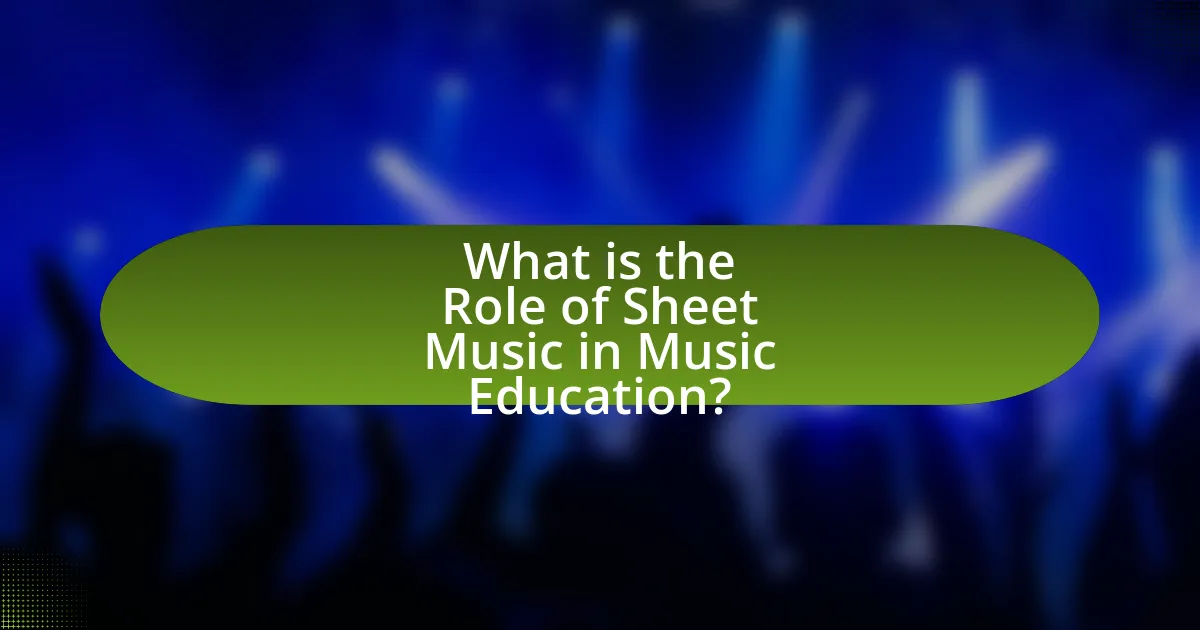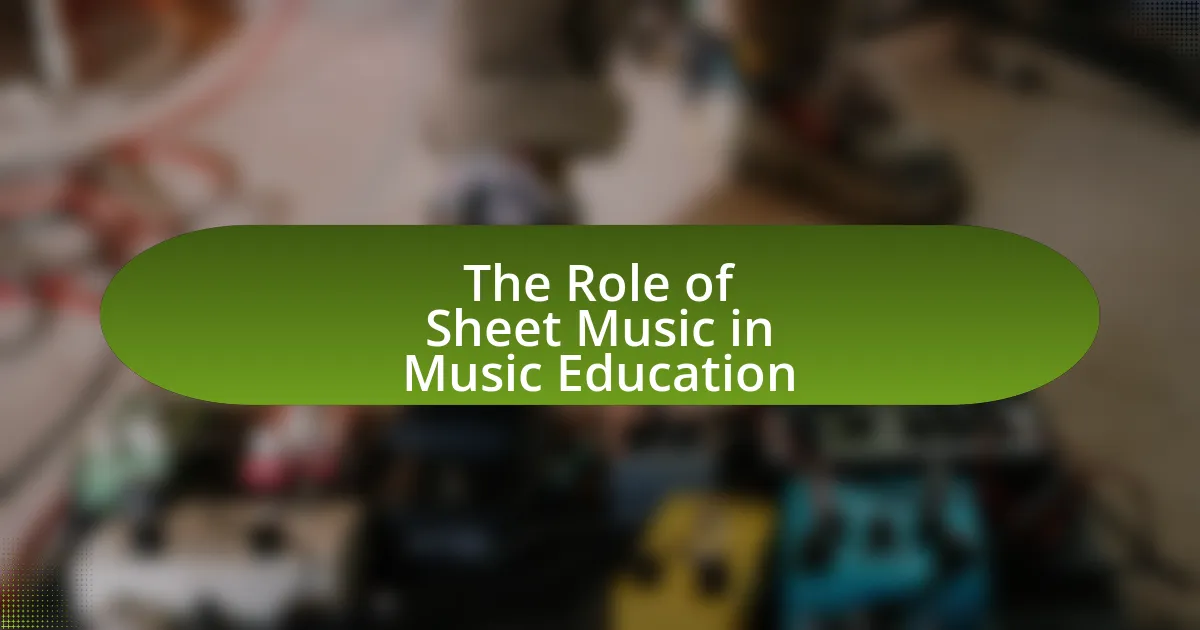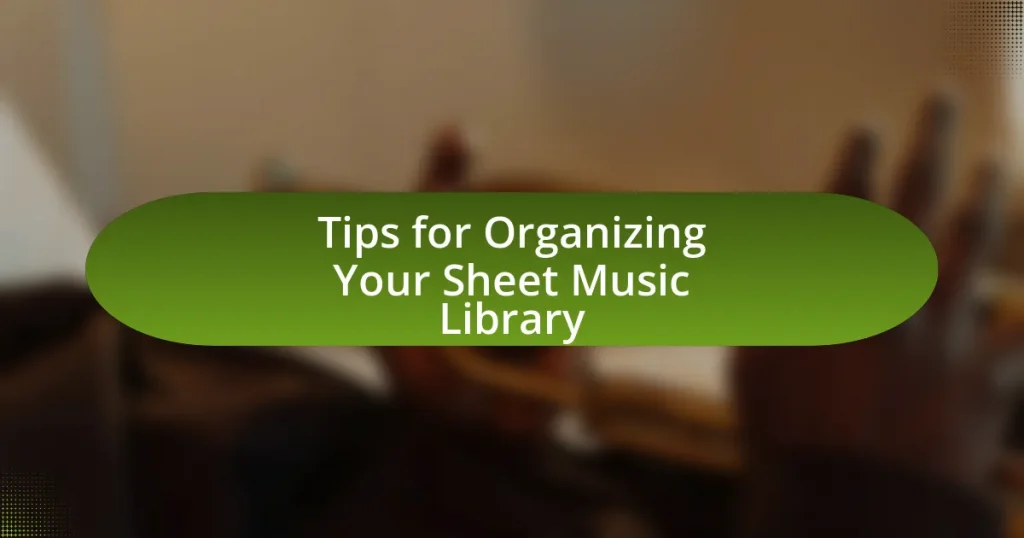The article examines the critical role of sheet music in music education, highlighting its importance as a standardized tool for learning and interpreting musical compositions. It discusses how sheet music enhances students’ sight-reading skills, cognitive abilities, and overall musical proficiency, supported by research findings. Key elements of sheet music, such as staff, notes, and time signatures, are outlined to illustrate their contribution to understanding music theory. The article also addresses challenges students face when learning to read sheet music across various instruments and genres, as well as effective strategies for educators to integrate sheet music into their teaching methods. Additionally, it explores the historical evolution of sheet music in education and the impact of technological advancements on accessibility and learning.

What is the Role of Sheet Music in Music Education?
Sheet music plays a crucial role in music education by providing a standardized method for students to learn and interpret musical compositions. It serves as a visual representation of music, allowing learners to understand rhythm, melody, harmony, and dynamics. Research indicates that students who engage with sheet music develop better sight-reading skills, which enhances their overall musical proficiency. For instance, a study published in the Journal of Research in Music Education found that students who practiced with sheet music showed significant improvement in their performance abilities compared to those who relied solely on auditory learning. This evidence underscores the importance of sheet music as an essential tool in the music education process.
How does sheet music facilitate learning in music education?
Sheet music facilitates learning in music education by providing a visual representation of musical notes and rhythms, which aids in the understanding of music theory and performance. This visual format allows students to decode musical language, recognize patterns, and develop sight-reading skills essential for playing instruments or singing. Research indicates that students who engage with sheet music demonstrate improved retention of musical concepts and enhanced cognitive skills related to music comprehension. For instance, a study published in the Journal of Research in Music Education found that students using sheet music showed a 30% increase in their ability to perform complex pieces compared to those relying solely on auditory learning methods.
What are the key elements of sheet music that aid in understanding music theory?
The key elements of sheet music that aid in understanding music theory include the staff, notes, clefs, time signatures, and key signatures. The staff consists of five lines and four spaces that represent different pitches, while notes placed on the staff indicate specific sounds and their durations. Clefs, such as treble and bass, determine the pitch range of the notes. Time signatures indicate the rhythmic structure of the music, specifying how many beats are in each measure and what note value constitutes one beat. Key signatures indicate the scale used in the piece, informing musicians about the sharps or flats that apply throughout the music. These elements collectively provide a framework for interpreting and performing music, facilitating a deeper understanding of music theory concepts.
How does reading sheet music enhance a student’s musical skills?
Reading sheet music enhances a student’s musical skills by developing their ability to interpret musical notation, which is essential for performance and composition. This skill allows students to understand rhythm, pitch, dynamics, and expression, enabling them to play pieces accurately and with emotional depth. Research indicates that students who regularly practice reading sheet music demonstrate improved sight-reading abilities, which correlates with better overall musical proficiency. For instance, a study published in the Journal of Research in Music Education found that students who engaged in sight-reading exercises showed significant gains in their musical understanding and performance skills compared to those who did not.
Why is sheet music important for different instruments in music education?
Sheet music is important for different instruments in music education because it provides a standardized method for musicians to read, interpret, and perform music accurately. This standardization facilitates communication among musicians, allowing them to collaborate effectively, regardless of their instrument. Additionally, sheet music serves as a tool for developing essential skills such as sight-reading, rhythm comprehension, and musical expression. Research indicates that students who engage with sheet music demonstrate improved cognitive abilities related to music theory and performance, enhancing their overall musical proficiency.
What specific challenges do students face when learning to read sheet music for various instruments?
Students face several specific challenges when learning to read sheet music for various instruments, including the complexity of musical notation, the need for simultaneous multi-tasking, and the variability in instrument-specific techniques. The complexity of musical notation involves understanding various symbols, such as notes, rests, dynamics, and articulations, which can overwhelm beginners. Additionally, students must simultaneously read the music, interpret it, and execute the corresponding fingerings or techniques on their instrument, which requires significant cognitive and motor coordination. Furthermore, different instruments have unique notational systems and techniques; for example, string instruments use different finger placements compared to wind instruments, adding another layer of difficulty. These challenges are supported by research indicating that music reading skills develop over time and require consistent practice and exposure to various musical contexts.
How does sheet music vary across different musical genres and styles?
Sheet music varies significantly across different musical genres and styles, reflecting the unique characteristics and requirements of each genre. For instance, classical music typically employs detailed notation, including dynamics, articulations, and phrasing, to convey the composer’s intentions, while jazz sheet music often features lead sheets that provide chord symbols and melody lines, allowing for improvisation. In contrast, popular music may use simplified chord charts or lyric sheets, focusing on accessibility for performers. This variation is supported by the historical context of each genre; classical music has a long tradition of formal notation, while jazz emerged in a more improvisational culture, leading to different notational practices.
What are the historical perspectives on the use of sheet music in music education?
The historical perspectives on the use of sheet music in music education reveal its evolution from a tool for notation to a fundamental component of teaching and learning music. In the 16th century, the advent of printed music facilitated wider access to compositions, allowing for standardized teaching methods. By the 18th century, composers like Bach and Mozart utilized sheet music to convey complex musical ideas, which became essential in formal education settings. The 19th century saw the establishment of conservatories that emphasized reading and interpreting sheet music as a core skill for musicians. This shift was supported by pedagogical methods from figures such as Zoltán Kodály and Carl Orff, who integrated sheet music into their teaching philosophies, emphasizing its role in developing musical literacy. Thus, sheet music has historically been integral to music education, shaping how music is taught and learned across generations.
How has the role of sheet music evolved over time in educational settings?
The role of sheet music in educational settings has evolved from a primary tool for teaching music literacy to a multifaceted resource that supports diverse learning styles and technological integration. Historically, sheet music served as the main medium for instruction, enabling students to learn musical notation and performance skills. In the 20th century, the introduction of various teaching methods, such as the Orff and Kodály approaches, emphasized the importance of experiential learning alongside traditional sheet music.
In recent years, digital technology has transformed the use of sheet music, allowing for interactive learning experiences through apps and online platforms. This shift has made sheet music more accessible and adaptable, catering to individual student needs and preferences. Research indicates that incorporating technology in music education enhances engagement and retention, demonstrating the evolving role of sheet music as not just a static document but a dynamic educational tool.
What impact did technological advancements have on sheet music accessibility in education?
Technological advancements significantly improved sheet music accessibility in education by enabling digital formats and online distribution. The transition from physical to digital sheet music allows students and educators to access a vast library of resources instantly, often at lower costs. For instance, platforms like IMSLP provide free access to thousands of public domain scores, facilitating learning and teaching. Additionally, software applications enable users to create, edit, and share sheet music easily, enhancing collaborative learning experiences. This shift has democratized access to music education, allowing a broader range of students to engage with diverse musical repertoires.
How can educators effectively integrate sheet music into their teaching methods?
Educators can effectively integrate sheet music into their teaching methods by using it as a foundational tool for developing students’ musical skills. This integration can be achieved through structured lessons that focus on reading, interpreting, and performing music from sheet music. For instance, incorporating sight-reading exercises helps students improve their ability to read music notation quickly, which is essential for ensemble playing and solo performances. Research indicates that students who engage with sheet music regularly demonstrate enhanced musical literacy and performance skills, as evidenced by studies showing that consistent practice with sheet music leads to better retention of musical concepts and improved overall musicianship.
What are the best practices for using sheet music in music education?
The best practices for using sheet music in music education include selecting appropriate repertoire, integrating technology, and encouraging active engagement. Selecting repertoire that matches students’ skill levels ensures that they can successfully learn and perform the music, which fosters confidence and motivation. Integrating technology, such as digital sheet music and apps, enhances accessibility and allows for interactive learning experiences. Encouraging active engagement through activities like sight-reading, improvisation, and group performances helps students develop a deeper understanding of music theory and enhances their overall musicianship. These practices are supported by educational research, which indicates that varied and interactive approaches to learning music lead to improved retention and skill development.
How can teachers assess students’ proficiency in reading sheet music?
Teachers can assess students’ proficiency in reading sheet music through a combination of performance evaluations, written tests, and practical exercises. Performance evaluations involve observing students as they play or sing from sheet music, allowing teachers to gauge their ability to interpret notes, rhythms, and dynamics in real-time. Written tests can include identifying notes on a staff, understanding musical symbols, and transcribing melodies, which provide a clear measure of theoretical knowledge. Practical exercises, such as sight-reading sessions, challenge students to read and perform unfamiliar pieces, further demonstrating their proficiency. These methods collectively provide a comprehensive assessment of a student’s ability to read sheet music effectively.
What resources are available for educators to enhance sheet music instruction?
Educators can enhance sheet music instruction through various resources, including digital platforms, instructional books, and software applications. Digital platforms like SmartMusic and Noteflight provide interactive sheet music and practice tools, allowing students to engage with music in a dynamic way. Instructional books, such as “The Complete Musician” by Steven G. Laitz, offer comprehensive guidance on music theory and sheet music interpretation. Additionally, software applications like MuseScore enable educators to create, edit, and share sheet music, facilitating collaborative learning. These resources collectively support effective teaching strategies and improve student understanding of sheet music.
What are common challenges students face with sheet music in music education?
Students commonly face challenges with sheet music in music education, including difficulty in reading notation, understanding rhythm, and interpreting dynamics. Many students struggle with sight-reading, which can hinder their ability to perform music accurately. Research indicates that approximately 60% of music students report difficulties in translating written notes into sound, impacting their overall learning experience. Additionally, students often find it challenging to grasp complex rhythms, leading to mistakes during practice and performance. Understanding dynamics and expressive markings can also be problematic, as these elements require a deeper interpretative skill that develops over time.
How can students overcome difficulties in reading and interpreting sheet music?
Students can overcome difficulties in reading and interpreting sheet music by practicing regularly, using mnemonic devices, and breaking down the music into smaller sections. Regular practice helps reinforce note recognition and rhythm understanding, which are essential skills for reading music. Mnemonic devices, such as “Every Good Boy Deserves Fudge” for the lines of the treble clef, aid in memorizing note names. Additionally, breaking down complex pieces into manageable sections allows students to focus on mastering each part before combining them, leading to improved overall comprehension and performance. These strategies are supported by educational research indicating that systematic practice and memory aids enhance music literacy skills.
What strategies can be employed to improve sheet music literacy among students?
To improve sheet music literacy among students, educators can implement a combination of systematic instruction, interactive learning tools, and consistent practice routines. Systematic instruction involves teaching music theory fundamentals, such as note identification, rhythm patterns, and key signatures, which are essential for reading sheet music effectively. Interactive learning tools, such as music notation software and apps, can engage students and provide immediate feedback, enhancing their understanding and retention of musical concepts. Consistent practice routines, including regular sight-reading exercises and ensemble playing, reinforce skills and build confidence in reading music. Research indicates that students who engage in structured practice and utilize technology show significant improvement in music literacy skills, as evidenced by studies conducted by the National Association for Music Education, which highlight the correlation between these strategies and enhanced student performance in music education.
What practical tips can enhance the use of sheet music in music education?
To enhance the use of sheet music in music education, educators should incorporate interactive methods such as using technology to display sheet music on screens, which allows for real-time annotations and adjustments. This approach engages students more effectively and caters to various learning styles. Additionally, breaking down complex pieces into smaller, manageable sections can facilitate easier learning and retention. Research indicates that chunking information improves memory recall, making it a valuable strategy in music education. Furthermore, encouraging students to actively participate in sight-reading exercises can build their confidence and proficiency, as consistent practice in reading music has been shown to enhance overall musical skills.



